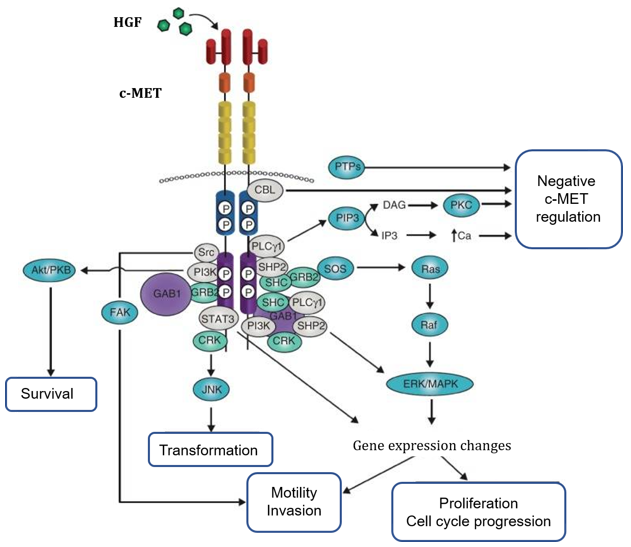
Our promise to you:
Guaranteed product quality, expert customer support.
 24x7 CUSTOMER SERVICE
24x7 CUSTOMER SERVICE
 CONTACT US TO ORDER
CONTACT US TO ORDER
MET Gene Editing 
MET, also known as the N-methyl-N'-nitroso-human osteosarcoma transforming gene, is a proto-oncogene encoding the hepatocyte growth factor (HGF) receptor tyrosine kinase. MET is 125 Kb in length, and located on chromosome 7q21-31 with approximately 21 exons. c-MET is a heterodimer composed of a 50 kDa highly glycosylated alpha chain and a 145-kDa beta chain, and this heterodimer consists of a large extracellular domain, a transmembrane segment, and an intracellular tyrosine kinase domain. c-MET is the only known high-affinity receptor for HGF.
The specific combination of c-MET and HGF induces a conformational change in the c-MET receptor protein and its intracellular protein tyrosine kinase domain is activated by autophosphorylation, then phosphorylating and activating downstream MAPK, PI3K, SRC, and STAT signaling pathways. The waterfall phosphorylation reaction gradually amplified the signal. Ultimately, the c-MET pathway triggers a variety of cellular responses, including cell migration, mitosis, morphogenesis, proliferation, and blood vessels, and plays an important role in wound healing, post-injury reactions, and degenerative diseases such as kidney and pulmonary fibrosis.
 Figure 1: c-MET signaling adaptors and mediators (Shawna Leslie Organ. 2011)
Figure 1: c-MET signaling adaptors and mediators (Shawna Leslie Organ. 2011)
In some NSCLCs, the c-MET pathway is considered to be the primary driving mechanism. c-MET signaling promotes hepatocyte proliferation and regeneration, indicating a potential tumor-promoting effect in HCC. c-MET dysregulation plays an important role in tumor formation, growth, maintenance, and invasion involving a variety of cancers, including lung cancer, colorectal cancer, liver cancer, and stomach cancer. Therefore, c-MET has become an attractive target for cancer treatment and drug development.
MET Gene Editing Service
CRISPR/Cas9 PlatformCB, a global leading biotechnological company specializing in gene editing, is dedicated to offering comprehensive CRISPR/Cas9 gene editing services and products to a wide range of genomics researchers. Based on our platform, we can help you effectively control target genes deleted, inserted or point mutated in cells or animals via CRISPR/Cas9 technology.
- MET Gene Editing Cell Line Generation
With deep gene editing knowledge and extensive experience in experimental operation and data processing, we have successfully implemented MET CRISPR/Cas9 gene edited in both easy-to-transfect cell lines and hard-to-transfect cells. To support your projects, we will offer you full-length custom MET gene editing service from strategy design to final stable cells. Our MET gene editing cell line generation services include:
➢ gRNA design and synthesis
➢ Transfect the cell lines you're interested
➢ Select the high expression cells and sort monoclonal cell
➢ Validate the knockout/knockin/point mutation of MET by PCR and sequencing
➢ Produce cryogenic preserved vials of stable cells and a final report
Typically, we develop CRISPR-mediated gene editing cell lines including HEK239T, Hela, HepG2, U87, but we can use other cell lines according to your requirements.
- Alternative cell lines
➢ Blood Lineage Cells (RAW264.7, HMC1.2, K562, U937 etc.)
➢ Cancer Cell Lines (HEK293, HEK293T, Hela, MCF7, Neuro2a, HepG2, U87 etc.)
➢ Stem Cells (iPSC)
➢ Other Cell Lines (NIH3T3, MCF10, HEME, SW10 etc.)
- MET Gene Editing Animal Model Generation
CRISPR/Cas9 PlatformCB also has extensive experience in incorporating CRISPR/Cas9 technology into animal models, which have been fully recognized by our clients. Tell us your needs, we provide a one-stop-shop MET CRISPR/Cas9 gene editing animal service and guarantee at least 2 founders or 3 F1 animals with shorter turnaround time and lower price. Our MET gene editing animal model generation services include:
➢ MET gene conventional knockout animals
➢ MET gene conditional knockout animals
➢ MET point mutation animals
➢ MET knockin animals
Alternative species: mouse, rat, rabbit, zebrafish, C. elegans, etc.
CRISPR/Cas9 PlatformCB is devoted to providing the best gene editing services and products for academic research, biotech research and pharmaceutical drug discovery with excellent quality management and quality assurance capacity. To accelerate the achievement of your research goals, our gene editing expert team provides you with custom CRISPR/Cas9 services for any specific gene to help you solve problems encountered during your research. If you have any question, please feel free to contact us.
Related Products at CRISPR/Cas9 PlatformCB
| CATALOG NO. | PRODUCT NAME | INQUIRY |
| CLKO-0012 | MET KO Cell Lysate-HeLa | Inquiry |
| CSC-RT0507 | Human MET Knockout Cell Line-HeLa | Inquiry |
References
- Hong-Nan Mo and Peng Liu. Targeting MET in cancer therapy. Chronic Dis Transl Med. 2017; 3(3): 148–153.
- Elizabeth A. Tovar and Carrie R. Gravee. MET in human cancer: germline and somatic mutations. Ann Transl Med. 2017; 5(10): 205.
- Bladt F. et al. Essential role for the c-met receptor in the migration of myogenic precursor cells into the limb bud. Nature. 1995; 376:768–771.
- Sattler M and Salgia R. c-Met and hepatocyte growth factor: potential as novel targets in cancer therapy. Curr Oncol Rep. 2007; 9:102–108.
- Sierra J.R and Tsao M.S. c-MET as a potential therapeutic target and biomarker in cancer. Ther Adv Med Oncol. 2011; 3:S21–S35.
- Scagliotti G.V. et al. The emerging role of MET/HGF inhibitors in oncology. Cancer Treat Rev. 2013; 39:793–801.
- Shawna Leslie Organ. An overview of the c-MET signaling pathway. Ther Adv Med Oncol. 2011; 3(1): S7–S19.